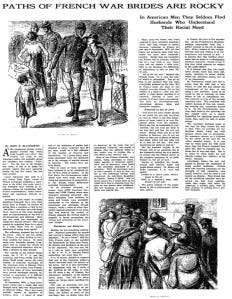Paths of French War Brides Are Rocky
Half a decade after World War I, how were marriages of American soldiers and European (mostly French) wives faring? In 1925, New York Times Magazine checked in and found the answer: not well.
The journalist John R. Ellingston wrote:
The records of the United States Army… testify that the figure 6,000 amply covers the total number of bona-fide marriages of the American Army in Europe. Five thousand of the brides were French.
…
As to how many of these marriages have proved downright failures, resulting in separation, it is difficult to learn because of insufficient statistics… [but] the estimates of people best situated to know indicates that 30% would be a fair estimate of the number of divorces and separations.
Needless to say, the divorce or separation rate would ultimately prove higher than 30%. After all, the article was written only six years after the armistice was signed in 1919. Over subsequent years and decades, surely even more such marriages broke up.
According to the French writer Hilary Kaiser, author of French War Brides: Mademoiselle & The American Soldier, about half of such marriages ultimately ended in divorce.
This shouldn’t have been much of a surprise, Ellingston surmised, since the marriages were arguably born of lust more than true love:
Soldiers, emerging from isolation in camp and trench, were peculiarly susceptible to the glamour of the mysterious and charming French woman; while a sense of often hysterical national gratitude to an army that had insured the victory of France disposed the French maid to magnify to heroic proportions the virtues and attractions of the American trooper.
Also noteworthy to modern eyes: the 1925 article’s sub-headline calls the French a different “race,” rather than a different “nationality” as we would today.
Paths of French War Brides Are Rocky: In American Men They Seldom Find Husbands Who Understand Their Racial Need
Published: Sunday, August 2, 1925


